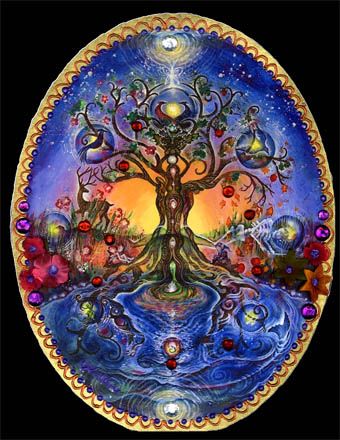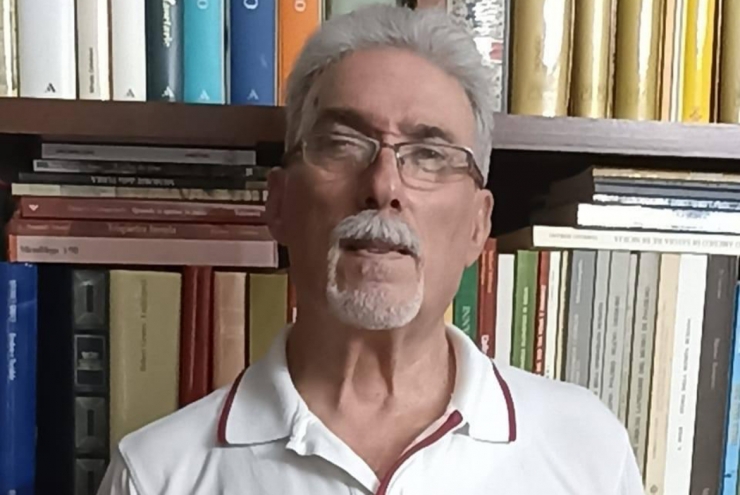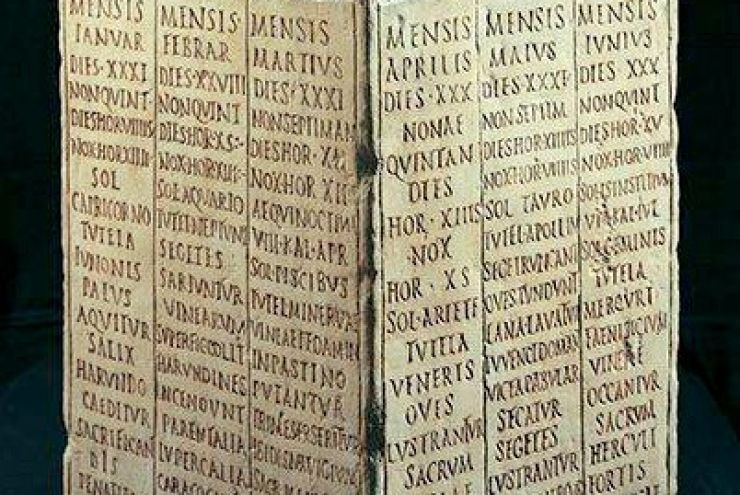 Plato was a great visionary, a revolutionary of philosophy, a valiant captain crossing the Ocean of Knowledge. He dared to leave the natural philosophy of the perceptible world and to reach the verticality of the world of forms. He understood that earlier philosophy was not dealing with reality, but with an incomplete and deluding representation of reality, a sort of hologram.
Plato was a great visionary, a revolutionary of philosophy, a valiant captain crossing the Ocean of Knowledge. He dared to leave the natural philosophy of the perceptible world and to reach the verticality of the world of forms. He understood that earlier philosophy was not dealing with reality, but with an incomplete and deluding representation of reality, a sort of hologram.
We must remember Plato as a philosopher, a lover of Sophia, and not as the chief of a religious sect. The basis of Plato’s thought is the free investigating mind. For this reason, we should not be surprised if his disciples were not proposing again and again his teaching. As a matter of fact, they often refuted important parts of his doctrine and started new paths. For instance, according to some authors, when Speusippus, Plato’s nephew, succeeded the Master in the lead of the Academy, he actually denied any link between ideas and material world, which was a fundamental postulate of platonic philosophy.
We have already seen that Xenocrates left the school because of a quarrel with Speusippus. Xenocrates was not the only one opposing the new ruler of the school, as also another philosopher left, someone who had been one of Plato’s followers for around twenty years and who was to draw a lasting mark on the history of philosophy: Aristotle.
Aristotle is often presented as an opponent to Plato, because he founded the Lyceum or Peripatos, a school that was in competition with the Academia. However he was a real follower of an important part of Plato’s philosophy, keeping on investigating on metaphysics with an incomparable analytic approach. Actually Aristotle deeply analyzed the implications of Plato’s “second navigation”, and took care of defining rigorously the metaphysics itself, enriching it with meanings and providing a logical frame. As Neoplatonism, and in particular Proclus’ work, used some import ant concepts from Aristotle’s philosophy, it is useful to review the main ideas of the great philosopher about metaphysics, starting from the fundamental question: what is metaphysics?
According to Aristotle, metaphysics deals with what is beyond natural philosophy (metaphysics can be literally translated as “what lays beyond the natural world”). Metaphysics is pure knowledge, with an absolute value, different from every other kind of knowledge that can be related to some utility or gain. Metaphysics is a knowledge for pure love of knowledge (philo-Sophia) by the enquiring mind, so it is divine and, therefore, it is also theology. Aristotle said: “All the other sciences are more necessary that this one, but no one is superior” (note 1).
Aristotle defined metaphysics in a rigorous manner according to four kind of research objects:
1) Metaphysics of the first causes, or etiology;
2) Metaphysics of the being, or ontology;
3) Metaphysics of the essence, or ousiology;
4) Metaphysics of divinity, or theology.
Historically, the four objects of metaphysics appeared in the order shown above. The first philosophers of the Milesian school dealt with the research of arkhé, or the first principle, the cause of everything. Then Parmenides introduced the Being as the first cause, founding the ontology, that it is the second object of metaphysics. Later, several philosophers investigated on the Essence or Substance (ousía) that is in everything (homeomeries, atoms, etcetera). The last kind of object is the divine, studied by all the philosophers, but by Plato in a special way.
In this article we briefly review the first two objects of Aristotle’s metaphysics: etiology and ontology.
Metaphysics of the First causes (Etiology)
The first object of metaphysics is the research of the first causes. According to Aristotle a first cause, or principle, is what provides the base, the structure and the foundation. Causes need to be finite, as it is not acceptable to have an infinite sequences of “because”. In our world, which is characterized by continuous transformation, causes are reduced to the following four: 1) formal cause, 2) material cause, 3) efficient cause, 4) final cause.
Formal and material causes are “static”. An example can clarify more than a long explanation: let’s consider a car, whose formal cause may be its project or design, as idea before material realization. Its material cause is then all the matter (car body, engine, electronics, etc.) that actually constitutes the final product. If we consider the becoming of the world, then we can wonder on the reason why a car appeared in a certain point in time (because it was manufactured by a plant) and for which reason (in order to be sold and used), that are respectively the efficient and the final causes. The four kinds of causes are still in use today in several types of analyses and are important definitions to understand Neoplatonic mystic, and in particular Proclus’ theology.
Metaphysics of the Being (Ontology)
Plato affirms that the Being is transcendental and universal. Sometimes it has the characteristics of a realm or of a dimension. This doctrine troubled his successors with the problem on how to connect the material world and its multiplicity and becoming with the eternal and transcendental Being. Neoplatonic authors faced the great distance between the Being and the perceptible world and tried to define a bridge, by introducing several halfway levels, making smoother the passage from one level to the next one. But Aristotle followed a different approach. If, on the one hand, Plato affirms that the Being is transcendental and universal, Aristotle believes that what was historically treated by various authors as “the Being” (τὸ ὄν) actually was a set of analogous meanings that are pointing to a unitary concept, the “ousía” (οὐσία), the ultimate reality of everything. Note that the term ousía was introduced by Plato himself.
We need to define a good translation of “ousía” and to understand the differences with respect to the Being. Cicero translated the Greek word into Latin “essentia”, from which term we derive the English “essence” that we are going to use. However Boethius uses also “substantia”, in English “substance” , to translate hypostasis (ὑπόστασις = sub-stantia), which Aristotle uses as synonym of ousía. The usage of the term “substance”, which has to be understood as “what remains under the apparent mutation of quality of phenomena”, can be misleading as sometimes “substance” is also used for the philosophical term ὑποκείμενον, that we will translate as “substrate”. For the sake of clarity we are using here and in the following articles preferably essence as translation of ousía and avoid the usage of substance, unless really related to the more material aspect of the essence.
Aristotle believed that only the Being-in-itself coincided with essence, i.e. the truth itself of the reality of things, while in general the word “being” in philosophy indicated a set of different concepts related to essence. Essence is defined by Aristotle as τὸ τί ἦν εἶναι, that can be translated as the Being of what is, meaning what remains beyond any transformation.
Considering this difference between Being and Essence, the various meaning of Being can be summarized as follows: 1) Being as per Categories; 2) Being as potentiality and actuality; 3) Being as true or false; 4) Being as accidental.
Being as per categories. Aristotle identifies ten categories that represent the way of being. Actually the first category, the essence, is the fundamental one, while the rest are different meaning of being in relation to essence: quality, quantity, relation, action, passion, place, time, belonging, laying. Essence and its characteristics define a grid of coordinates on which every existing entity can be expressed: this is the base of everything.
Being as per potentiality and actuality. Aristotle introduces a very important concept for our journey in the Neoplatonic mysticism: potentiality (δύναμις = dynamis) and actuality (ἐνέργεια = energheia, or also ἐντελέχεια = entelekeia) are two way of being, two polarities. Being in actuality is the visible way of being. Being in potentiality is the capability to be in actuality. By this idea Aristotle introduces the becoming in the being. Potentiality and actuality are not categories of being. They are two polarities that can be manifested in each category. The concept of potentiality has been widely used by Proclus, resulting in a fundamental aspect of the cosmological structure of propagation from the One down to the matter.
Being as True or False. This way of being is related to logic, the discipline invented by the Aristotle to study the logos as abstract reasoning function.
Being as Accidental. This is the weakest form of Being, fully in the becoming. It is an occasional condition in which the matter happen to be in a certain moment.
At this point it is clear that Aristotle, dealing with these four typology of the Being, needed to find a unify factor. In the following article the Essence and it metaphysics will be presented.
Mario Basile
Note 1: ἀναγκαιότεραι μὲν οὖν πᾶσαι ταύτης, ἀμείνων δ᾽ οὐδεμία (Aristotle, Metaphysics 1, 983a).
















